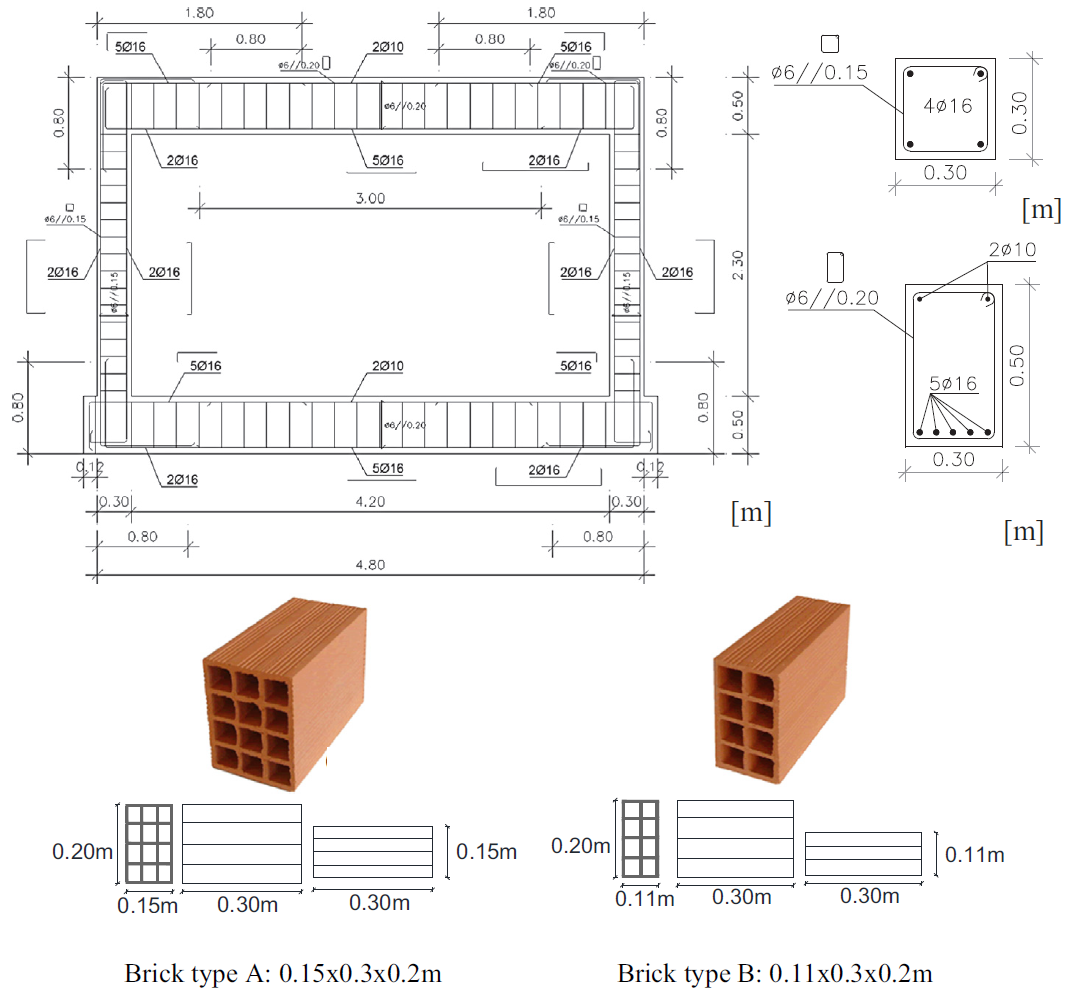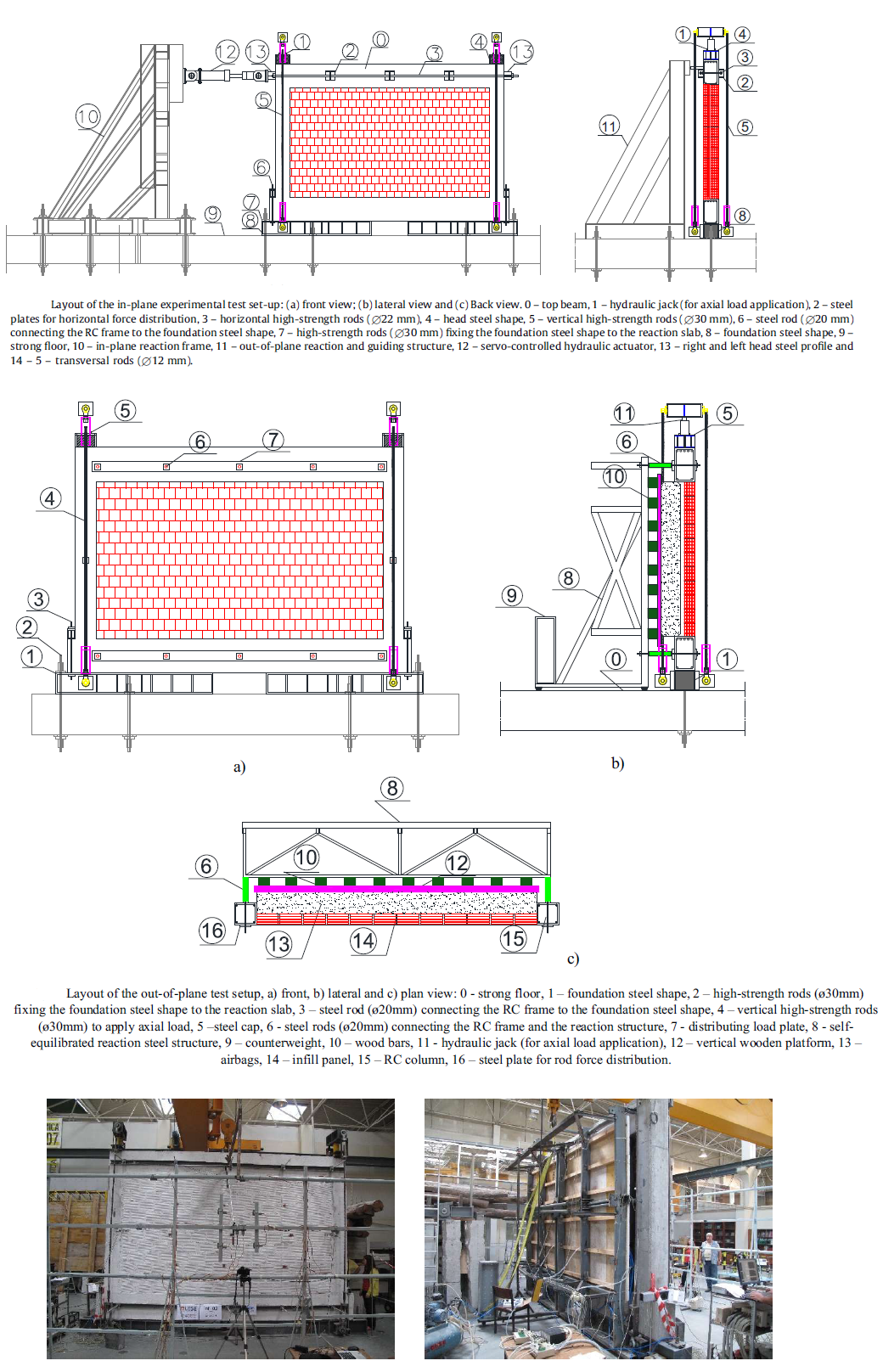This paper reports an experimental campaign carried out at the LESE at the Faculty of Engineering of the University of Porto in order to study the out-of-plane behaviour of IM walls, and the influence of the previous in-plane drift in their out-of-plane response. For this, three full-scale infill panels were constructed and were subjected to out-of-plane monotonic and cyclic loading, with and without previous in-plane drift. The out-of-plane loading was applied by using an innovative structure that was specially constructed to undertake this type of experimental test. The experimental test set-up was presented, including all the instrumentation and loading conditions.
PROBLEM
It is consensual that further and deeper knowledge is required of the out-of-plane behaviour of IM walls to develop effective retrofit strategies that prevent this type of collapse and consequently protect the buildings’ users’ safety, as well as that of people near the building. The study of this type of collapse mechanism is also important to support the development of accurate numerical models that represent the expected behaviour of IM walls subjected to out-of-plane loadings, combined or not with in-plane loadings.
AIM AND SCOPE
evaluation of the out-of-plane performance with different in-plane damage levels, variations in the dimensions of the IM walls, and different types of masonry bricks.
DESIGN AND CONSTRUCTION OF THE TEST SPECIMENS:
The present experiments comprised three out-of-plane tests of full-scale infilled RC frames, two of them without previous inplane damage and one with previous in-plane damage. The general dimensions of the specimens were selected as 4.80 x 3.30 m and the cross sections of the RC columns and beams were 0.30 x 0.30 m and 0.30 x 0.50 m, respectively, which are representative of those existing in the Portuguese building stock.
All infill panels have equal geometry with in-elevation dimensions of 2.30 x 4.20 m made of horizontal hollow clay bricks, as usually found in the most common masonry in Portugal. No reinforcement was used to connect the infill panel and the surrounding RC frame. Three infill panels were built (denoted as Inf_01, Inf_02 and Inf_03), all having an external leaf (150 mm thick) aligned with the external side of the RC beam. For the panel Inf_03, an internal leaf, 110 mm thick, was added aligned with internal side of the beam, leaving a hollow thickness of 40 mm. This double leaf panel was first tested for in-plane cyclic displacements, after which the internal leaf was removed, leaving the external leaf to be tested under the same out-of-plane loading conditions as for panel Inf_02.
----------------------------------------------------------------------------------------------
| Test | Previous IP | Axial | Number | Brick |
| number | drift (%) | load (kN) | of leafs | size (mm) |
|--------|-------------|-----------|----------|------------------------------------------------|
| Inf_01 | - | 300 | 1 | 300 x 200 x 150 |
| Inf_02 | - | 300 | 1 | 300 x 200 x 150 |
| Inf_02 | 0.5 | 300 | 2 | 300 x 200 x 150 (ext.); 300 x 200 x 110 (int.) |
----------------------------------------------------------------------------------------------
Specimen detail:

Test setup:

CONCLUSIONS
A significant difference was found between the test results, with and without previous in-plane damage, namely:
(a) the maximum strength was almost four times higher for the tests without previous in-plane damage and for higher out-of-plane drift values;
(b) a significant reduction in the initial stiffness was observed in the test with previous in-plane damage when compared with the others;
(c) a significant maximum strength reduction was found in the tests without the previous in-plane damage, which was not verified in Inf_03.
The failure modes observed in each of the tests reveal a different out-of-plane behaviour of the IM walls with and without previous in-plane damage. The tests on original IM walls (Inf_01 and Inf_02) showed vertical cracking, with detachment between the infill panel and the surrounding RC frame in the top and bottom joints. In the Inf_02 test wall, trilinear cracking was observed with deformation concentrated in the middle point of the wall, with slight cracking in the top joint. For the test with previous in-plane damage, detachment was observed between the infill panel and the surrounding top beam and columns, and typical rigid body behaviour was found.
Regarding the in-plane test of a full-scale double-leaf IM wall, continuous increase in the in-plane strength up to 0.25% drift was observed, after which the strength stabilized. There was no strength degradation up to 0.5% drift, but clear stiffness degrada-tion was found during the test. The maximum strength was characterized by a diagonal crack, starting in the weak panel, and detachment relative to the surrounding RC frame, particularly after 0.3% drift when the top beam in both panels became clearly detached and corner crushing was found in the strong panel.
RECOMMENDATIONS FOR FUTURE RESEARCH
In order to complement the present study and the global findings, experimental tests should be performed in the future according to the following objectives:
(i) out-of-plane tests of IM walls with previous in-plane damage for different levels (0.25%, 0.75%, 1%, 1.25% and 1.5% of in-plane drift);
(ii) performing similar testing campaign for different IM wall thickness (hollow clay bricks 300 x 200 x 110 mm and 300 x 200 x 220 mm);
(iii) out-of-plane tests of IM walls with openings (different sizes and disposition) without and with previous in-plane damage. With this complementary studies the full characterization of original IM walls out-of-plane behaviour will be achieved.










